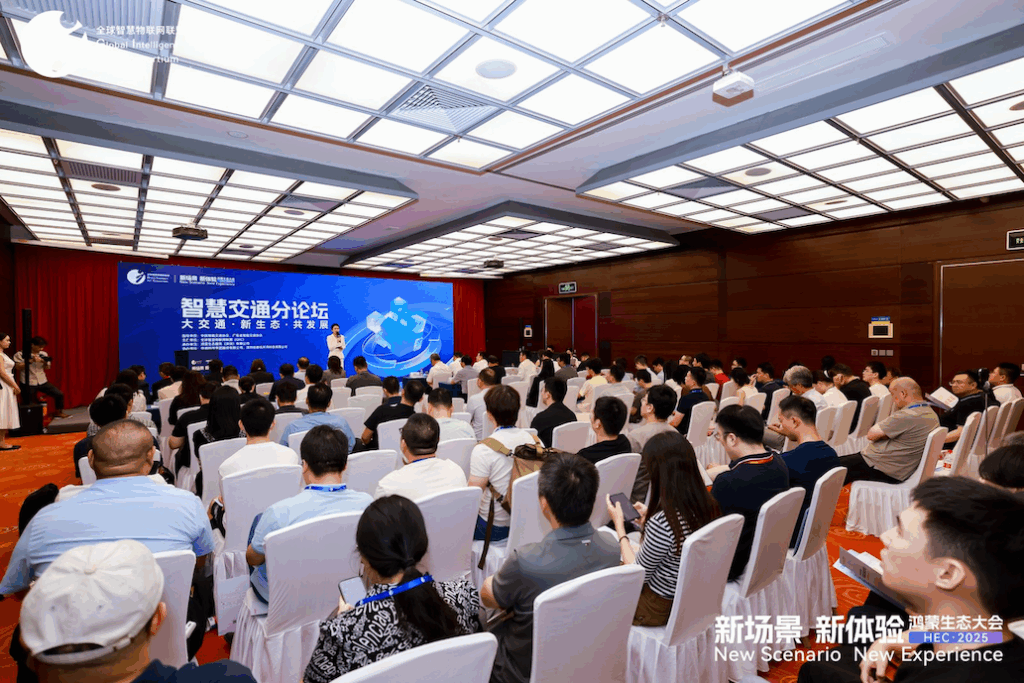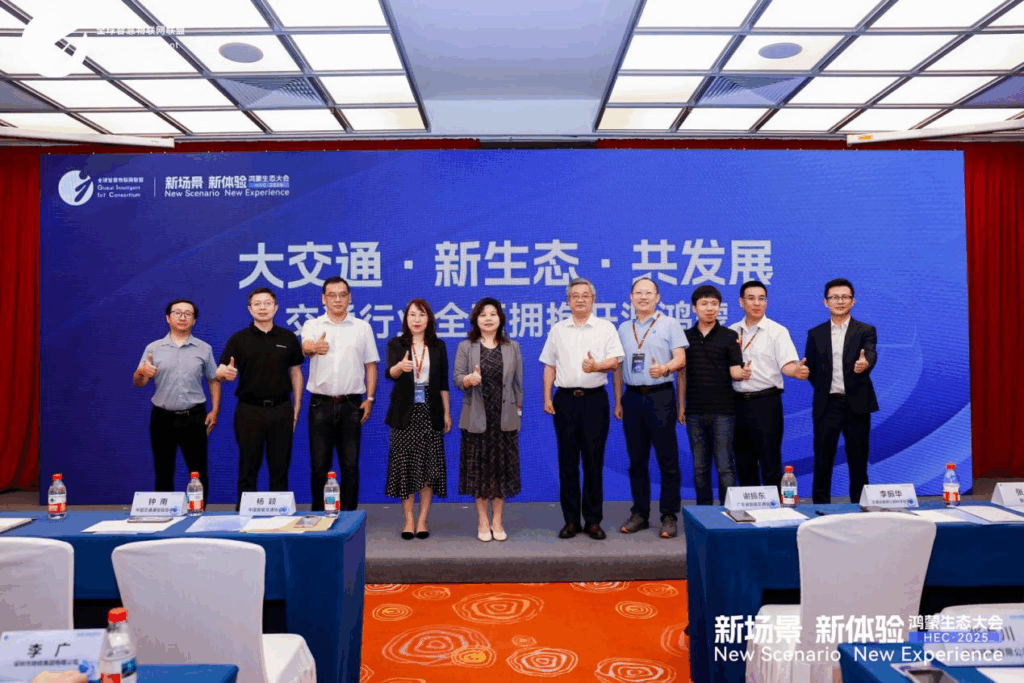On August 30, the Harmony Ecosystem Conference 2025 was grandly held in Shenzhen. On that day, the "OpenHarmony Smart Transportation Forum," guided by the China Intelligent Transportation Association and the Guangdong Intelligent Transportation Association, hosted by the Global Intelligent IoT Alliance, and organized by Harmony Ecosystem Services, was successfully held.
Themed "Major Transportation・New Ecosystem・Joint Development," the forum brought together multiple forces from government, enterprises, academia, research, and application to jointly explore the value and integration points of OpenHarmony in the digital and intelligent transformation of the transportation industry. Guests from various fields shared their practices and outlooks in areas such as highways, railways, buses, and subways. The forum also launched the "Initiative for the Transportation Industry to Fully Embrace OpenHarmony," marking the comprehensive launch of the Harmony ecosystem across various transportation fields.

Yang Ying, Secretary-General of the China Intelligent Transportation Association, said in her speech at the forum that the association will fully support the co-construction of the Harmony ecosystem, support the deepened collaboration among leading enterprises, developers, ecosystem partners, and users, and accelerate the large-scale implementation of transportation solutions based on OpenHarmony,,such as Traffic Harmony. Together, they will promote the further expansion and improvement of the Harmony transportation ecosystem. More cities and transportation scenarios will be integrated into the Harmony ecosystem to achieve cross-regional and cross-field transportation coordination. The association expects the Harmony transportation ecosystem to make greater contributions to the innovative development of the intelligent transportation industry.
Xie Zhen, President of the Guangdong Intelligent Transportation Association, emphasized that the operating system is the underlying cornerstone of intelligent systems, and the Harmony ecosystem provides a historical opportunity for operating system-level innovation in the transportation industry. The association will fully leverage its platform's aggregation role, focusing on supporting leading enterprises in the province to deepen the construction of the Harmony ecosystem in the transportation field. In three dimensions - technology co-creation, standard co-construction, and scenario co-expansion - they will jointly build a vibrant, in-depth, and influential intelligent transportation Harmony ecosystem, contributing to intelligent transportation in Guangdong Province and even globally.
Zhong Nan, head of the Smart Transportation Business Department at the China Communications and Information Center, delivered a keynote speech titled "Characteristics and Development Path of Information Innovation in the Transportation and Communications Industry." Combining the large scale of transportation infrastructure, the diversity of transportation modes across regions and industries, the importance of transportation information security, and the complexity of application scenarios, he proposed a development path for information innovation in the transportation industry led by policy, industry, technology, and security.
Li Zhenhua, Deputy Director of the Industry Key Laboratory at the Ministry of Transport's Road Science Research Institute, delivered a keynote speech titled "Practice and Outlook of Harmony Ecosystem in the Highway Field." He said that China has built the world's largest highway electromechanical system network. With the increasing scale, problems such as a wide variety of equipment, difficult coordination, and high construction and maintenance costs have emerged. Faced with these issues, the Road Science Research Institute has taken the lead in conducting "key technology research and application of the highway electromechanical Harmony operating system." The key technologies of this operating system have reached the international leading level, have been applied and demonstrated in 11 provinces across the country, and have won the "Mao Yisheng Science and Technology Award - Special Prize for Transportation Science and Technology."
Professor Jin Yi from the School of Computer Science and Technology at Beijing Jiaotong University delivered a keynote speech titled "Application Research of Artificial Intelligence in the Railway Field and Exploration of Open Source Ecosystem Path." She shared her team's experience and achievements in the "artificial intelligence + railway" field and introduced six questions about the open-source ecosystem under the intelligent railway scenario. She looks forward to the collaborative innovation and development of "OpenHarmony + artificial intelligence + railway" to solve these problems.
Wang Kai, Chief AI Scientist at Jiadu Technology, delivered a speech titled "Traffic Harmony: Towards a New Era of Smart Interconnection in Subways." He shared the development process, technical architecture, product panorama, and urban rail transit application cases of Traffic Harmony. Jiadu Technology will join hands with subway users in Shenzhen and other places to achieve scenario-based innovation based on Traffic Harmony, promote the intelligent development of urban rail transit business, improve passenger experience, and increase operation and maintenance efficiency. Zhang Da, General Manager of the Intelligent Hardware Center at Zhida Xink Company, shared his experience in "Practice of Bus Cockpit Based on OpenHarmony." He said that the new bus ecosystem under OpenHarmony has achieved interconnection and integration of bus stops, station equipment, buses, and mobile terminals, bringing experience improvements in convenience and comfort for citizens, safety and intelligence for drivers, efficient operation for bus companies, and precise perception for city managers.
Zhang Da, General Manager of the Intelligent Hardware Center at Zhida Xink Company, shared his experience in "Practice of Bus Cockpit Based on OpenHarmony." He said that the new bus ecosystem under OpenHarmony has achieved interconnection and integration of bus stops, station equipment, buses, and mobile terminals, bringing experience improvements in convenience and comfort for citizens, safety and intelligence for drivers, efficient operation for bus companies, and precise perception for city managers.

The Harmony ecosystem in the transportation industry is rapidly booming. Currently, there are eight transportation distributions based on OpenHarmony, five types of transportation Harmony such as Traffic Harmony and Road Harmony, and they have been applied in more than ten provinces. There are more than 45 types of transportation equipment based on OpenHarmony, and they have been applied in multiple scenarios such as tunnels, toll stations, and cockpits in six fields including highways, subways, buses, ports, and water transport, achieving a dual improvement in experience and benefits.
"Major transportation, new ecosystem, joint development," it is believed that under the collaboration of all parties, the Harmony transportation ecosystem will enter the fast lane and flourish in more fields of the transportation industry, achieving the goal of high-quality coordinated development between the Harmony ecosystem and intelligent transportation.